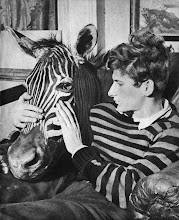The 1997 David Lynch film LOST HIGHWAY was not well received by critics, who labeled it a "surrealistic" "neo-noir" and "incoherent." I contest these charges on all counts. While Lynch's style is strongly expressionistic, his work contains little in the way of non-sequitur or the gleeful anti-rational assault characteristic of Surrealism. And, though it borrows some of the genre's iconography, LOST HIGHWAY is not particularly concerned with the moral philosophy of the Noir genre and cannot properly be labeled as such. As to the charges of incoherence, one must wonder if the confounded parties were paying attention at all. While the world of LOST HIGHWAY may not behave like ours, there is a powerful internal logic at work, and the learning curve is not much higher than anything in the director's prior work. Indeed, the film fits comfortably in the continuum of Lynch's filmography as a particularly bold foray into the director's longtime thematic concerns. The film is good, and you should watch it.
But my intention here is not to mount a defense of LOST HIGHWAY or a tirade against its brainless fuckhead critics, nor will I attempt a top-to-bottom analysis (if you are looking for a thorough working of the film, I suggest Slavoj Zizek's ON THE ART OF THE RIDICULOUS SUBLIME, which I found quite astute). Instead, I wish only to say a couple words regarding one facet of the film, which is objects. So let's talk about objects.
Strange Objects abound in the work of David Lynch-- a mound of dirt on a dresser, a severed ear, a log, a blue rose, and the list goes on and on. There are a number of these in LOST HIGHWAY; I'm thinking in particular of Fred and Renee's cavernous house and the photograph at Andy's place. These are not just scattered around for the effect of ambient weirdness, although they are, in a way, content-empty.
The theme of strange objects is a familiar one in the cinema tradition. We see them often in the form of the MacGuffin, the object desired by all characters, the pursuit of which drives the film. The characteristic of the MacGuffin is that it is not the unique nature of that object which causes it to be desired; rather, it is a repository of desire and a placeholder for their fulfillment. The object itself is unimportant. It could be anything.
Because of their position within the economy of desire, MacGuffins are a pretty good place to start as we try to unravel the nature of the Strange Object. After all, in Lynch world, desire is the name of the game. Lynch's films take place at the contact points where the undercurrent of repressed desire starts to rub against the fabric of the constituted self. In Freudian terms, we might say that Lynch films deal with intrusions of the id into the domain of the ego, and the attempts of the superego to regulate these intrusions.
Lynch toys with MacGuffins (what is behind the door in Ben's apartment in BLUE VELVET?), but this is not exactly what we are talking about when we speak of the Lynchian Strange Object. After all, these objects are not merely abstract vessels beyond the vanishing point of desire, but play active roles in the drama, transmitting messages, triggering realizations, initiating changes. Frequently, they erupt with elemental energy, streaming fire, dust, smoke, light. A lamp is never just a lamp! These objects are nodes through which libido flows, coursing with energy that pours through from the world of forbidden desire!
In one magnificent scene from LOST HIGHWAY, Lynch diagrams the construction of a Strange Object. It happens in the midst of a vision; Fred Madison sees a burning cabin in the desert fold the fire back inside itself. Now the power is contained in the structure; we know that this is a contact point, the edge of the abyss, and when Fred goes there it will transform him.
Within this context, it is worthwhile to consider the idea of The Woman As Object as it pertains to Patricia Arquette's character, who manifests in two different forms over the course of the movie. In her initial form, she is Renee and is a subject, that is to say, a real character, though she is sketched from the perspective of Fred Madison. For Fred, Renee is an embodiment of mystery and terror, the impenetrable "feminine mystique" which he is unable to comprehend and therefore master. The contours of her desire elude him; she comes to be a symbol of his impotence, which we see played out in his pathetic attempt to sex her up. Renee is a brunette, and Lynch shoots her in dark hues, forever moving through the shadows, impossible to grasp.
Renee reincarnates as Alice Wakefield, who is not a character but an object, constituted in the fantasmatic reality of Pete Dayton. Alice is blond, filmed in light, sexually responsive, radiating energy like a battery. She is the object upon which the Pete Dayton fantasy is constructed, the nexus at which it has split off from reality. As he draws closer to her and the fantasy starts to degrade, she becomes more and more intense until, at the site of the desert cabin, that crypt of memory, that libidinal furnace, she glows like a light bulb, impossibly bright, impossibly charged, then folds back into the void as the fantasy splinters.





No comments:
Post a Comment